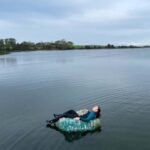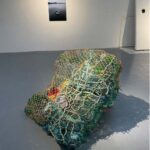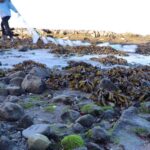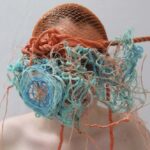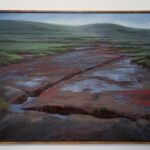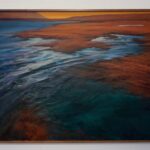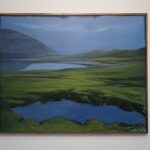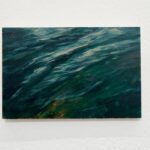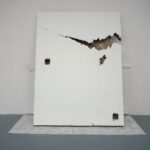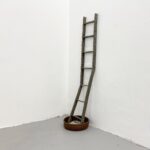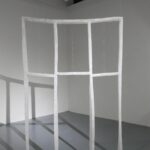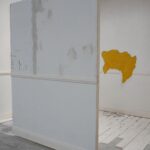T i e d
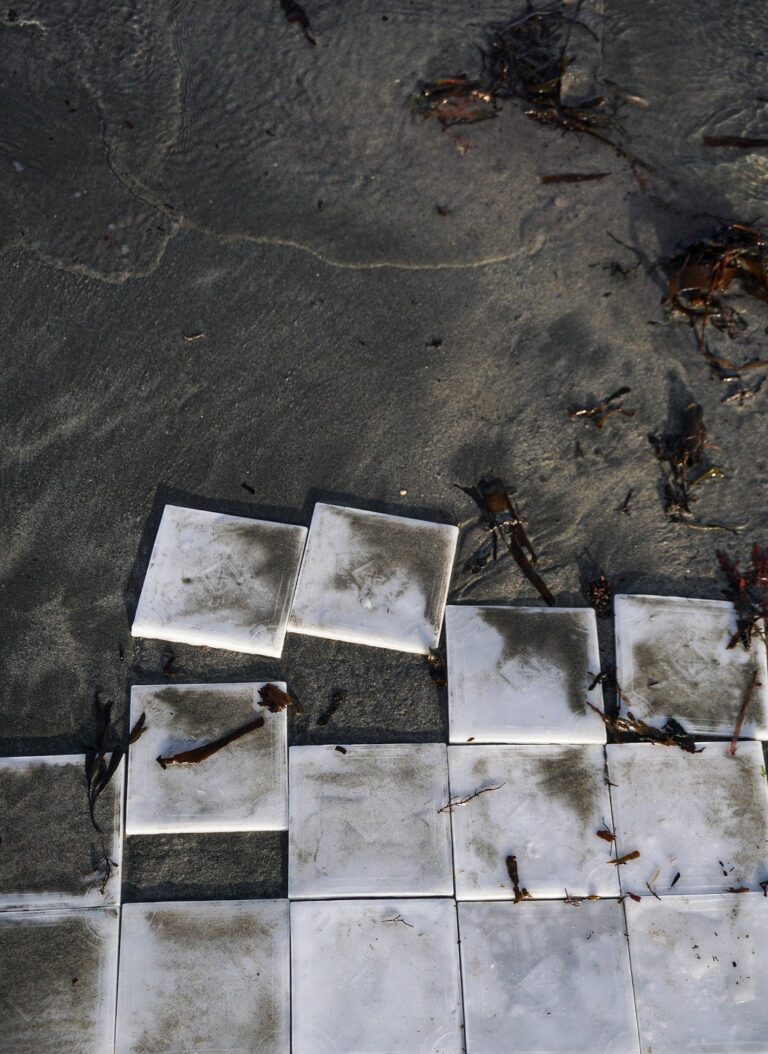
mfa exhibition
april 16-29, 2022
ELIZABETH BLEYNAT
TIFFANI LOVE
FRANCINE MARQUIS
OPENING RECEPTION | SATURDAY, APRIL 16 | 5-7PM
Also showing from April 16-21 in MFA and Barn Studios:
Post Baccalaureate | MA/MFA 1 Exhibition
i t e r a t i o n s | Undergraduate Exhibition
Gallery Hours: Monday-Friday 10:00am-5:00pm
contact@burrencollege.ie | 065 7077200
T i e d
Within all cycles, there is inevitably a slip into momentary chaos. The second wave of the pandemic closures had greeted us upon our arrival to the rural west of Ireland in 2020. The extreme physical and visual dualities existing in the Burren landscape were simultaneously seductive and isolating.
We struggled to connect amongst a barrage of yellow signages, which ostracized both the mind and the body. In summary, Danger: fear all forms of human contact. The notion of community had become taboo, a topic that was deemed criminal even in its vaguity. In an attempt to maintain our sanity, we humorously branded ourselves the COVID-Class, a name also befitting our small number, in accordance with the required two meter distancing.
Elizabeth Bleynat’s kaleidoscope of coastal plastic debris meets land in her meticulously interwoven tangles of mulitcoloured flotsam, delicately embedded within earth-toned sheep’s wool. Continuously sweeping the nearby shores and bays of Ballyvaughan, Bleynat detangles the blues, greens, and oranges of found synthetic fishing ropes. In one form of their re-assemblage, she fashions a garment, the knots of which tether her body to land during a rising tide.
Tiffani Love’s palette captures the liminality of a slowly vanishing coastal spit just west of the village of Ballyvaughan known as The Rine. Her solitary, pensive engagement with place seeps out onto the canvas as she illuminates subtleties within the landscape: alienated tidal pools rising and falling between grassy beds, shadowed breaks grooved dark and deep within the limestone, and sandy borderlines that smoothly separate shore from sea.
Whether fabricating, assembling, writing, sculpting, or deconstructing, all of Francine Marquis’s works are shaped through careful acts of layering. Interested in the relationship memory has with one’s emotional connection to architectural spaces, Marquis draws from the Latin root word memor, meaning mindful, as she recreates fragments from interior spaces/locations. Allowing her own memories to permeate, the built fragility of her installations makes the materiality of place precious: a memory that must be cared for or lost completely.
In a time of uncertainties and divides, through the parallel practices of collecting, routine, labor, technique, and remembering, artists Elizabeth Bleynat, Tiffani Love, and Francine Marquis have tied themselves to this place.
Follow the link below to listen to an interview with the MFA students on Clare FM:
https://www.clare.fm/podcasts/mfa-exhibition-burren-college-art-design/
Elizabeth Bleynat
Through my practice I investigate intersectional issues of enviromental degradation, queer embodiment, traditional womens work, non-binary thought, and global inequities. I have a background as a human rights advocate and charitable worker. My artworks consider human labour and eco-ethics, drawing parallels between a culture of disposability of material goods and of human labour.
The body of work for t i e d centres around ecofeminist thought. It advocates for mending and repurposing, for living more harmoniously with the planet, for restoration before exploitation, and for non-violent approaches to structural, societal change. Notions of labour, seen and unseen, are implicit and explicit within found plastic objects. Daily, plastic waste from fishing and agriculture accumulates on the shore of the coastal village I call home. I regularly remove quantities of rope and other detritus from the beaches and coves and bring them back to my studio. These waste plastics become the material base of my art practice from which I fabricate works. I employ both fine art techniques and craft techniques to give new purpose to discarded plastics. Imbuing value back into existent plastic material through art practice suggests an alternative way of life, one resistant to the linear nature of consumerism. In creating this work, I join legions makers and artists of contemporary societies’ in an effort to destabilise commercial production of plastic and the associated waste streams; piecing together sustainable practices from the goods already in the environment, prioritising mending over manufacturing, repurposing over single use consumption.
The work for t i e d demonstrates plastics in several forms, from matted ensnarements to barely visible, yet relentlessly present inclusions of plastic material within organic fibre. I have developed a mode of visual communication which transforms plastics from the macro to the micro and bodily. As such, I work with plastics in multiple visual iterations, from monumental sculpture, wearable props for performance, and plastic inclusions in felt. I assert felt is the most evocative of bodily concerns in the context of the west of Ireland. The work is visibly handmade borrowing techniques from the Appalachian crafts of my foremothers and the maritime knotwork I observed during my time working with merchant marines to evoke labour through density of form.
- Raft I 2021, performance and installation documentation
- Raft I 2021, performance and installation documentation
- Taking My Shame Out to Play 2021, video stills from performance documentation
- Barincle Mask 2021, documented performance
Tiffani Love
As a painter, I am interested in the liminal space existing between the sea and the land and how this borderline, the coastline, is constantly changing. The tide not only weaves together land and sea, but pulls me into the place as well. The current series of paintings, entitled An Rinn / The Rine, is based on a small coastal spit of land on the south-side of Galway Bay, in North Clare.
My process involves walking through the landscape and observing it directly from life, documenting these experiences on location through photography, video, and sketches. These solitary walks through the terrain open up space to reflect on the sensorial experience of the location. The rhythm of my walking mimics the rhythms of the natural world and is paralleled by the physical act of making a painting. Each painting becomes a shared conversation between the landscape, myself and the viewer.
- An Rinn The Rine, Burren, Co. Clare, Flood Tide, 0818, 11.10.2021. Oil on canvas
- An Rinn The Rine, Burren, Co. Clare, Flood Tide, 1647, 06.11.2021. Oil on canvas, 80x100cm
- An Rinn The Rine, Burren, Co. Clare, Flood Tide, 0805, 11.10.2021. Oil on canvas
- Coastline Studies II , oil on panel
Francine Marquis
Memories are crafted, built by the phenomena of being, and become etched into the spaces we inhabit. Pulling from my early years of relocating and from my later years spent living and working on an old Victorian home, I have developed a deep interest in how personal connections fasten themselves to architectural space and their features. With meticulously sculpted, casted, built, and fractured installations, I explore personal memories layered within the architecture of place and interior spaces. Often creating tactile sensorial experiences between my work and the audience, I welcome collaboration through physical engagement with my ‘installations in flux’, further troubling the distinction between construction and deconstruction, care and neglect.
Whether fabricating, assembling, writing, sculpting, or removing, my process-based practice is shaped by careful acts of layering and material choice. The built fragility of my installations highlights the ephemeral nature of all places: which memories will be cared for and which will be left to ruin?
the diy
There are cracks in the lintel,
broken by mourning and tied to the breath of this place.
Space.
There are veins in the cladding,
ten decades of river beds that beat it into submission.
Demolition.
Skins fray open borderlines: brick to insulation to its plaster d i vid e,
peeling at its construction.
Production.
- 2021-22, Two Place, Installation Shot
- 2021, Generations, Installation shot
- 2021-22, Two Place, Installation Shot
- 2021, A Wall To Your Memory, Installation Shot

